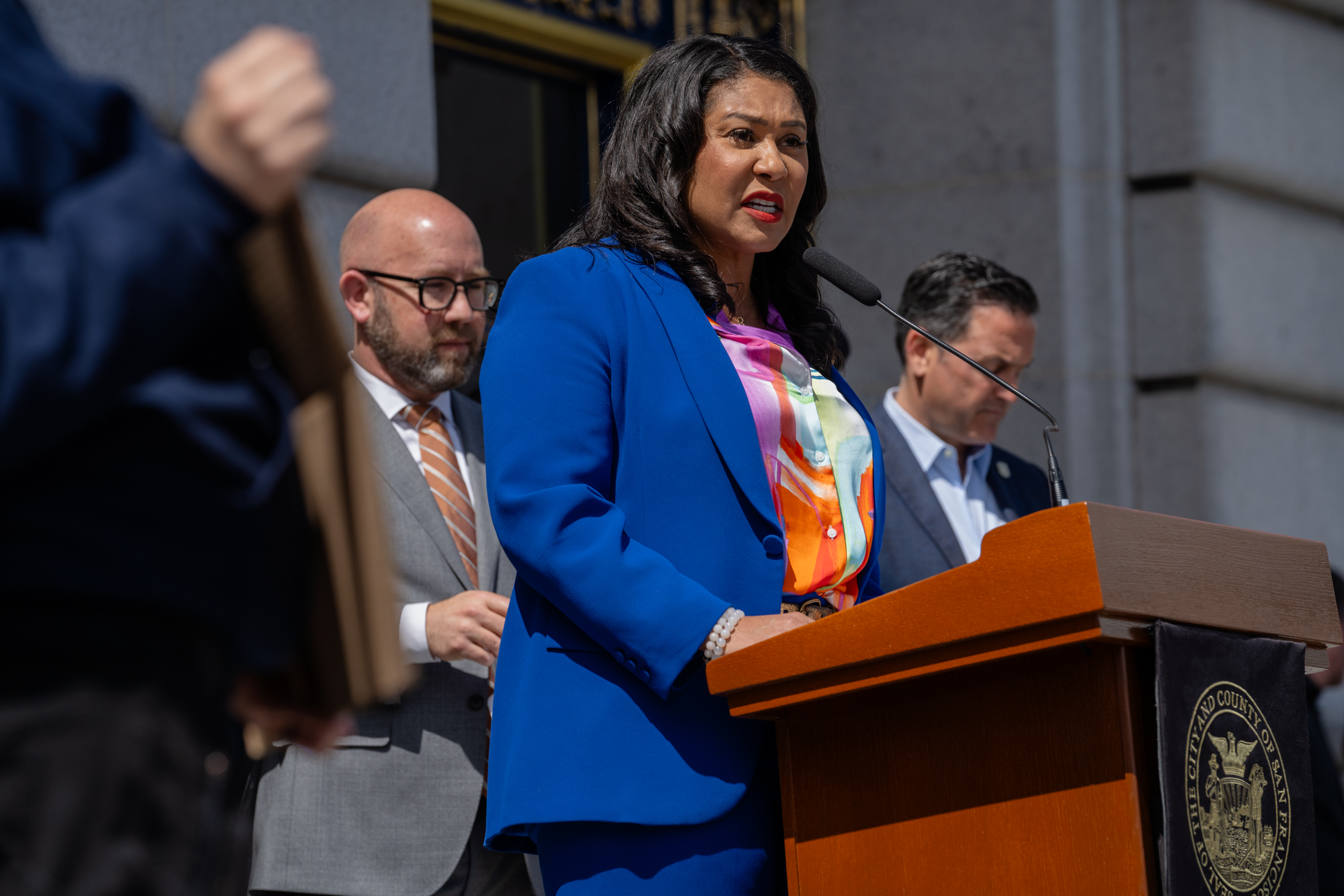San Francisco’s streets need a “complete overhaul,” Mayor London Breed said Thursday as she doubled down on the city’s plan to eliminate traffic fatalities two weeks after the horrific wrong-way crash that killed a family of four in the West Portal neighborhood.
“It is lessons from horrific events such as these that must inform how we move forward as a city,” Breed said at a press conference. “These streets were built for another time. They were designed for a world we no longer want to live in, where cars are prioritized and the only option.”
Breed’s proposal will place renewed emphasis on quickly improving safety at the city’s most dangerous intersections by adding physical features to protect pedestrians and slow down cars.
Standing on the steps of City Hall on Thursday, Breed and San Francisco’s transportation leaders commemorated the 10-year anniversary of the San Francisco Vision Zero initiative, which originally set the lofty goal of eliminating traffic fatalities in the city. The idea was to build infrastructure to make the streets safer, strategically crack down on dangerous driving and educate the public on safety.
But despite a decade of work and a budget climbing into the hundreds of millions of dollars, the initiative has failed to halt deaths on the city’s streets. In fact, the number of fatalities remains basically the same as when San Francisco first launched the program.
“We all know that this work has been much harder than any of us expected,” said City Attorney David Chiu, who was the Board of Supervisors president when then-Mayor Ed Lee first announced Vision Zero in 2014.
There have been 11 traffic fatalities so far this year, according to initial estimates from the San Francisco Municipal Transportation Agency. That places the city on track to outstrip the 26 traffic fatalities in 2023. If deaths continue at this rate, this year could become San Francisco’s deadliest for street deaths since Vision Zero began, topping the 39 fatalities in 2022.
Breed has her work cut out for her to convince some transportation activists that she means business on Vision Zero. Historically, her administration has had a lot of bark but little bite on street safety issues, according to advocate Luke Bornheimer.
“At the very best, the mayor has done very little to transform our streets,” Bornheimer told The Standard. “At worst, she’s rolled things back at a time where we need leadership more than ever before.”
Bornheimer and other activists have criticized Breed’s administration for reopening Great Highway Park to cars, taking too long to flesh out the city’s network of protected bike lanes, and letting endless red tape gum up the works on infrastructure projects.
Flanked by activists holding signs saying “Kill red tape not children” and “interagency coordination,” Breed acknowledged the roadblocks city bureaucracy has set for achieving Vision Zero.
“Too often street safety projects get stalled or slowed down,” Breed said. “But today we lay down our commitments to moving forward. This happens now.”
So, what’s the plan?
The sweeping plan the mayor announced Thursday is largely an extension of ongoing programs SFMTA has been working on for years under the Vision Zero umbrella.
She renewed her commitment to finishing quick-build safety projects on all 900 intersections in the High Injury Network, which is the 12% of streets where more than 68% of severe and fatal traffic crashes occur. The quick build program was launched in 2019 with the goal of delivering street safety improvements within weeks or months using materials that are modifiable, such as paint, posts and signs. But that speedy timeline has been elusive, with some so-called quick builds taking up to two years to implement.
Breed also wants to bar turning right on red at more intersections in the city. That’s on top of the Tenderloin, where turning on red is already banned, and the 200 downtown intersections SFMTA plans to make no-turn-red.
The plan also calls for increased removal of parking spots close to crosswalks, a practice called daylighting, which increases safety because drivers have a clearer view. Breed also directed SFMTA to launch additional enforcement to curb parking on the sidewalks and blocking crosswalks.
A significant number of street safety projects have already been completed under the Vision Zero banner in the past 10 years. For example, the city has installed more than 50 miles of safety improvements on the highest-injury streets, added 41 miles of protected bike lanes, and built over 700 traffic-calming devices, like speed humps, according to a Mayor’s Office spokesperson.
Despite Vision Zero’s failure to curb traffic fatalities, transportation leaders in and out of city government said they remain committed to its intent.
“Vision Zero is the right approach, the right goal,” said Walk San Francisco Executive Director Jodie Medeiros. “But we need so much more.”
